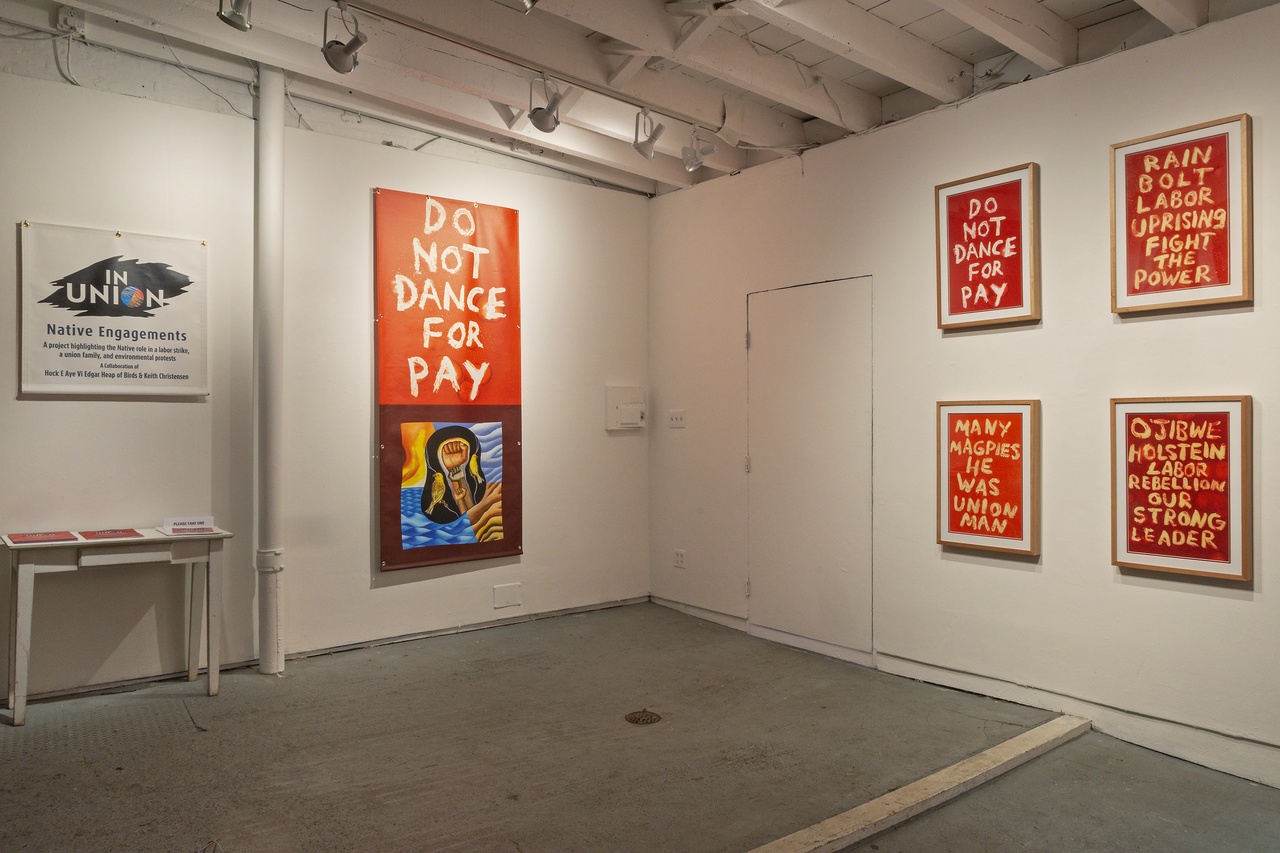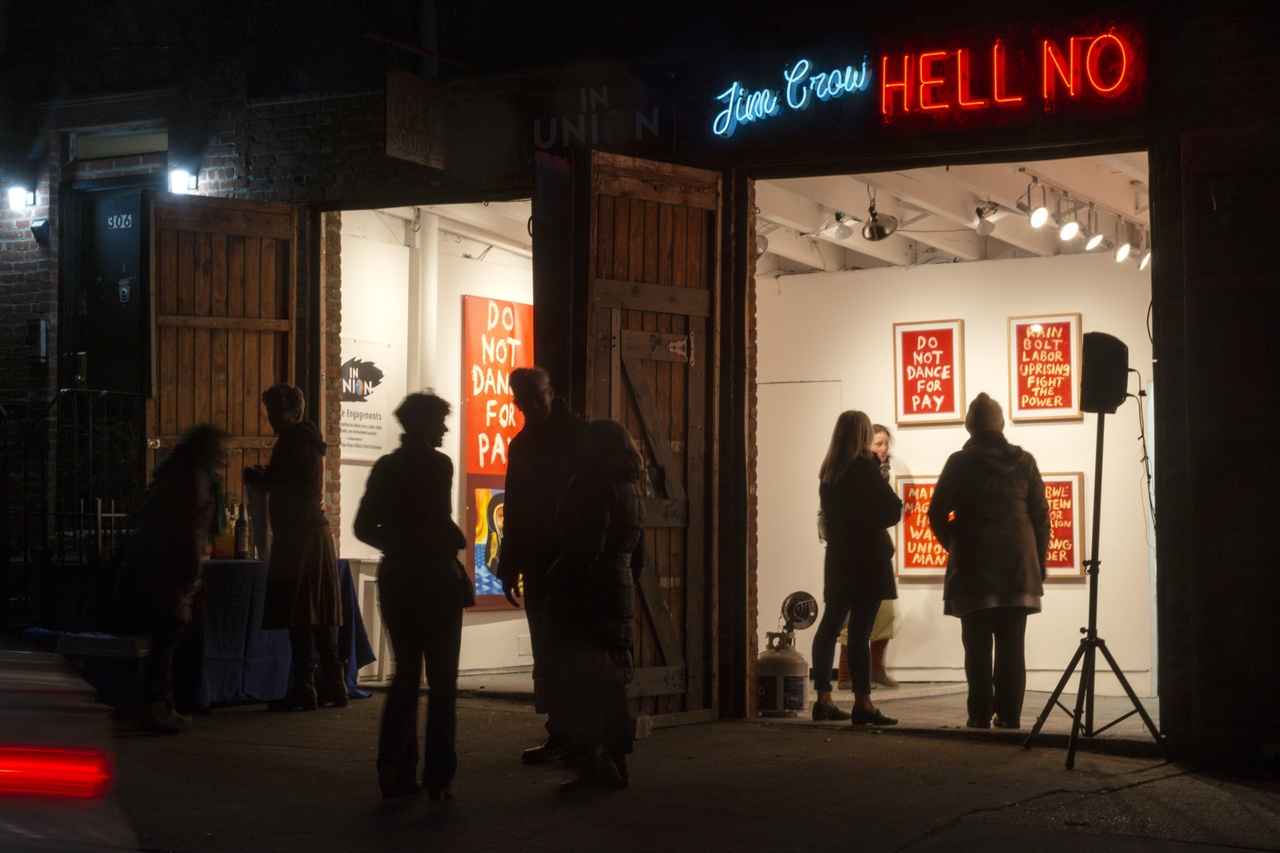COLLECTIVE ACTION Audra Verona Lambert on Hock E Aye Vi Edgar Heap of Birds and Keith Christensen at Open Source Gallery, New York

“Hock E Aye VI Edgar Heap of Birds and Keith Christensen: In Union,” Open Source Gallery, New York, 2023, installation view
Echoes of rebellion permeate Open Source Gallery’s exhibit “Hock E Aye Vi Edgar Heap of Birds and Keith Christensen: In Union.” Indigenous presence emerges in the first lines of the exhibition announcement, proclaiming the enduring relationship that the Lenape nation have to the lands also known as the New York City metropolitan area. “In Union” offers the chance to explore frameworks of resilience and advocacy from a Native American perspective. Native resistance has informed protest leadership at moments throughout labor rights history in North America, probing consideration of how Indigenous leaders have cultivated social progress. Hock E Aye Vi Edgar Heap of Birds here collaborates with figurative artist Keith Christensen in this presentation combining portraits of labor union leaders with the text-based artistic processes Heap of Birds is known for. Merging these two artistic practices offers visitors the ability to feel more connected to protest histories, offering space for generative discourse on Native identity and labor rights.
Visitors to the exhibit are surrounded by towering vermillion banners mounted to the wall. On them, portraits of Indigenous union leaders with upright posture, are flanked by abstracted compositions evoking the four elements. These banners, which might be read as potential protest signs waiting to be activated, are split, each with the portrait of a labor leader featured in one half, accompanied by the leader’s name and a protest rallying cry, such as “Fight the Power,” in the other. These works dually act as artistic compositions and objects of resistance, replete with iconography communicating the power of collective struggle. This collaborative exhibition in many ways continues a dialogue of resistance proposed by Edgar Heap of Birds, member of the Cheyenne and Arapaho Tribes of Oklahoma, over the years in his text-based practice. His brief yet immediate messages, sharp like modern Japanese tanka poems, reflect on the effects of violence on Indigenous populations. After completing an MFA from the Tyler School of Art in Philadelphia in 1979, he presented a message in Times Square, New York City, partially written in the Cheyenne language; as part of the “Messages to the Public” presentation in 1982 by the Public Art Fund, that work was featured alongside those of other conceptual artists like Jenny Holzer. This public broadcast sensibility has remained a thread connecting texts across various formats in Heap of Birds’s practice. Prior to this exhibit, the artist included evocative messages in his 2019 exhibition at MoMA PS1, “Surviving Active Shooter Custer.” The exhibition title referenced unprovoked public violence, and it featured bold monotype prints snapped together into tight grids, each presenting a phrase in white text on a red background. Statements such as “Bullets Are Rapid Flesh Is Soft” and “Do Not Dance for Pay” – a message which also features as part of “In Union” – were installed at the museum, where on an adjacent wall, Heap of Birds transmuted these messages through a printing technique utilizing clear oil to create works he refers to as “ghost prints.” These prints relayed the same messages, arranged identically, and their copied, bleached-out messages against faded backgrounds conveyed the same statements, legible yet worn through, haunting but still relevant.

“Hock E Aye VI Edgar Heap of Birds and Keith Christensen: In Union,” Open Source Gallery, New York, 2023, installation view
For “In Union,” Hock E Aye Vi Edgar Heap of Birds continues these potent messages against hegemonic violence by working with Keith Christensen in this exhibit as collective action. Christensen was raised in the US Midwest and had first met Heap of Birds in the 1980s in New York. Their paths crossed again in Minneapolis, during protests in the aftermath of the murder of George Floyd in 2020. Christensen shared his knowledge of the formative Truckers’ Strike, also known as the Teamsters’ strike, of 1934 in that same city, remarking on the impact of Indigenous leaders guiding the strike. This conversation sparked the collaboration that eventually formed “In Union.” Christensen’s careful portraits offer a pointed visual contrast to Heap of Birds’s sweeping, hand-drawn style of text. Native union strike leaders of the Truckers’ Strike who are depicted for “In Union” include Ray Rainbolt (of Dakota heritage) and Emmanuel “Hap” Holstein (of Ojibwe heritage), whose images are buoyed by Heap of Birds’s messages of solidarity stretching across these banners. By foregrounding Indigenous leadership in labor strikes, the artists emphasize the transformative effect it had on the 1934 Truckers’ Strike. Despite a series of violent actions against the strike, which called for stronger worker rights and protections. The unions won, setting a precedent for labor victories such as the National Labor Relations Act of 1935, which resulted in the right to engage in collective bargaining, for example.
Heap of Birds enshrines the spirit of unionizing in these banner messages, forming a vessel to carry the enduring spirit of protest efforts spanning from the Depression-era strike at the center of this exhibition’s premise to more recent environmental conservation efforts. To make these links explicit, a publication of the same title as the show accompanies the works on view, offering a wider perspective on how these activists – unionizers and water pollution protest organizers – are connected across generations of protest action. “In Union” thus confronts the viewer directly and unequivocally with a powerful combination of text and imagery. Heap of Birds is known for his distinctive treatment of text that incorporates printmaking to blur and converge individual letters as part of a special process. For the artist, this style is critical: continuing his “ghost prints” aesthetic, the text presented throughout “In Union” holds a palpable sense of slippage mimicking the fissures obscuring Indigenous presence from the hegemony of colonial history. Christensen’s portraits of the union leaders hold the works steady against this tendency toward lapsed memory.
A former garage, Open Source Gallery is a space semi-open to the elements that welcomes passersby freely. Itself an artistic takeover of an existing structure, the gallery serves as a fitting chamber for resistance acts: the intimacy of the venue provokes immediate and visceral responses to the messages on display, similar to the shoulder-to-shoulder jostling of protestors and their slogans during marches. The size of the space in no way limits the enduring spirit of struggle contained within its walls: when it comes to resistance, precedent is vast, and it is emphatic.

“Hock E Aye VI Edgar Heap of Birds and Keith Christensen: In Union,” Open Source Gallery, New York, 2023, opening
In considering the extension of protest strategy into the present day, water protector and artist Cannupa Hanska Luger’s practice comes to mind. Luger’s Mirror Shield Project (2016) was a series reenvisioning protective shields as unique, reflective artworks that individuals could create and utilize during the 2016 protests at Standing Rock. Luger (of Mandan, Hidatsa, Arikara and Lakota heritage) sees objects such as these mirrors as crucial to water protection efforts. It can be tempting in protest to diminish past actions in order to instead warn against apocalyptic futures. Luger reflects: “As an indigenous person, I don’t relate to [apocalypse] narratives, as my people have already survived an apocalypse.” [1] Heap of Birds echoes this sensibility when he mentions: “Every day is a political day, every day is a historical day, and we have to fight back.” [2] These water protectors directly echo the work of Indigenous leaders fighting to protect laborers – the Minneapolis Teamsters in 1934 – against brutal working conditions, seeking a habitable world for those of us inheriting it from past generations, and ensuring access to equitable conditions for future generations.
Reflecting back on the faces leading the Truckers’ Strike, Christensen captures the portraits of Native leaders in a manner not nostalgic, but relatable. We observe Rainbolt’s distinct cheeks, his steady gaze and posture. Holstein’s portrait carefully marks him as a man stridently facing forward with a determined expression evidenced in his stern mouth and furrowed brow. These depictions solidify the humanity of these historical figures and make concrete the voices rising in the din. Meanwhile, another banner on view depicts multiple raised fists layered over one another, flanked by birds, in reference to Edgar Heap of Birds’s own ancestral line. The banners evoke both the lingering presence of those who came before us and the aspirational power of hope for the future.
“In Union” may take as its focus the Minneapolis Truckers’ Strike of 1934, but the continued force exerted by generations continuing this legacy of resistance is undeniable. Christensen and Heap of Birds have shifted the spotlight onto the palpable presence that Indigenous protest leaders have exerted – and continue to exert – at North American protest sites. These demonstrations persist; they dive deep into the earth only to reemerge and impact future generations. Echoing these continued efforts, Heap of Birds shares words of wisdom from his grandmother: “You came, but what are you gonna give – what can you offer?” [3] “In Union” reminds us that resistance is a timeless and necessary act of giving power to the people.
“Edgar Hock Aye Vi Heap of Birds and Keith Christensen: In Union” at Open Source Gallery, Brooklyn, New York, February 11–March 24, 2023.
Audra Verona Lambert is a Brooklyn-based curator and art writer with a background in public art. Her scholarship in the field primarily consists of grassroots arts activism and coalition-building research. She has organized exhibitions for the Yeshiva University Museum and Amos Eno Gallery, among other nonprofit and commercial spaces. She has written numerous catalog essays, and her writing has appeared in Whitehot Magazine, Portray Magazine, Cultbytes, HuffPost, and more.
Image credit: Courtesy of Open Source Gallery, photos Stefan Hagen
Notes
| [1] | Maria Manuela, “Survival Is Indigenous,” New Mexico Magazine, March 16, 2020. |
| [2] | “Artist Talk with Hock E Aye VI Edgar Heap of Birds and Keith Christensen Moderated by Lou Cornum.” |
| [3] | Ibid. |
